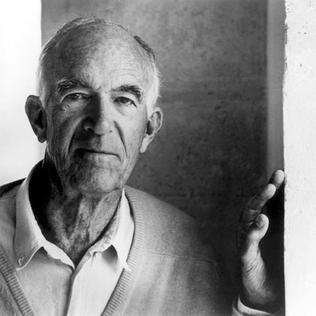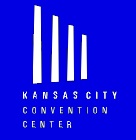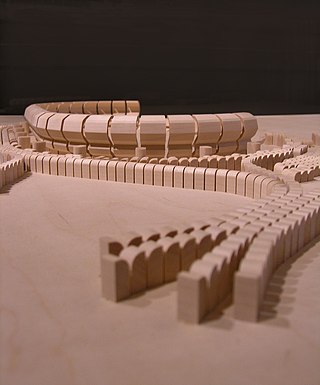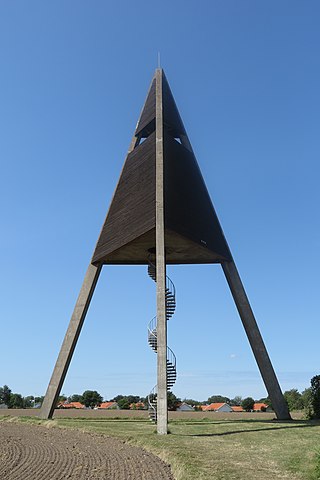
A column or pillar in architecture and structural engineering is a structural element that transmits, through compression, the weight of the structure above to other structural elements below. In other words, a column is a compression member. The term column applies especially to a large round support with a capital and a base or pedestal, which is made of stone, or appearing to be so. A small wooden or metal support is typically called a post. Supports with a rectangular or other non-round section are usually called piers.

The Sydney Opera House is a multi-venue performing arts centre in Sydney, Australia. Located on the foreshore of Sydney Harbour, it is widely regarded as one of the world's most famous and distinctive buildings and a masterpiece of 20th-century architecture.

Jørn Oberg Utzon was a Danish architect. In 1957, he won an international design competition for his design of the Sydney Opera House in Australia. Utzon's revised design, which he completed in 1961, was the basis for the landmark, although it was not completed until 1973.
The year 1982 in architecture involved some significant architectural events and new buildings.

The Kansas City Convention Center, originally Bartle Hall Convention Center or Bartle Hall, is a major convention center in downtown Kansas City, Missouri, USA. It was named for Harold Roe Bartle, a prominent, two-term mayor of Kansas City in the 1950s and early-1960s. Its roof is suspended by four tall art deco inspired pylons, as a component of the Kansas City skyline.

Precast concrete is a construction product produced by casting concrete in a reusable mold or "form" which is then cured in a controlled environment, transported to the construction site and maneuvered into place; examples include precast beams, and wall panels for tilt up construction. In contrast, cast-in-place concrete is poured into site-specific forms and cured on site.
Kuwaiti architecture is a style of architecture unique to Kuwait, a country founded in the early 18th century. Before the discovery of oil, Kuwait has an economy reliant on maritime trade, shipbuilding, caravan trade and the pearl industry. The economy improved by the discovery of oil, enabling more economic growth.

Bagsværd Church is a Lutheran church in Bagsværd on the northern outskirts of Copenhagen, Denmark. Designed in 1968 by Jørn Utzon, it was completed in 1976. The building is considered to be a masterpiece of contemporary church architecture, especially its bright, naturally illuminated interior and its ceiling straddled with softly rounded vaulting.

The Fredensborg Houses form a housing complex in natural surroundings on the outskirts of the small town of Fredensborg in the north of Zealand, Denmark. The houses were designed by Jørn Utzon for Danes who have worked for long periods abroad.

The Utzon Center in Aalborg, Denmark, was the last building to be designed by Jørn Utzon, the architect behind the Sydney Opera House. In collaboration with his son Kim, who provided the final construction drawings, he planned the centre not as a museum but as a place where students of architecture could meet and discuss their ideas for the future. Located on the Limfjord waterfront in the city where Utzon spent his childhood, the building was completed in 2008, the year Utzon died.

Can Lis is a house the Danish architect Jørn Utzon built for his wife Lis and himself near Portopetro on the Spanish island of Majorca. Completed in 1971, it consists of four separate blocks linked together by walls and courtyards.

Additive Architecture is an approach used by Danish architect Jørn Utzon to describe his development of architectural projects on the basis of growth patterns in nature.

The Svaneke water tower, in the small town of Svaneke on the Danish island of Bornholm, was designed by award-winning architect Jørn Utzon and completed in 1952. It was the first successful project of the architect who would later design the Sydney Opera House.

The Skagen Odde Nature Centre, on the northern tip of Denmark's Jutland, is a museum devoted to the effects of sand, water, wind and light. It was designed in 1989 by Jørn Utzon, the celebrated architect behind the Sydney Opera House. Under the leadership of his son Jan, the centre was completed in 2000.

The Elineberg Housing development consists of six high-rise apartment buildings located in the residential area of Elineberg in Helsingborg, south-western Sweden. Completed in 1965, the 13 to 15 storey towers were designed by the Danish award-winning architect Jørn Utzon who, at the time, was working in Helsingborg with the Swedish architectural firm Arton in conjunction with architects Erik and Henry Andersson.
Jan Utzon is a Danish architect. The son of Jørn Utzon, with whom he worked closely on several prestigious projects, he has completed a number of fine works of his own including the Performing Arts Centre in Esbjerg.
The Melli Bank, University of Tehran Branch, was designed by Danish architect Jørn Utzon, famed for his Sydney Opera House. The three-storey rectangular building on Enghelab Street near the centre of Tehran, Iran, was completed in 1962.
A bibliography of books and material related to the Architecture of Denmark:

Graceville Uniting Church is a heritage-listed former Uniting church at 215 Oxley Road, Graceville, City of Brisbane, Queensland, Australia. It was designed and built by Walter Taylor from 1917 to 1951. It was previously known as Graceville Methodist Church. The associated churchyard complex was added to the Queensland Heritage Register on 24 September 1999.

A double tee or double-T beam is a load-bearing structure that resembles two T-beams connected to each other side by side. The strong bond of the flange and the two webs creates a structure that is capable of withstanding high loads while having a long span. The typical sizes of double tees are up to 15 feet (4.6 m) for flange width, up to 5 feet (1.5 m) for web depth, and up to 80 feet (24 m) or more for span length. Double tees are pre-manufactured from prestressed concrete which allows construction time to be shortened.
![Main building kuvett naassn[?] asNbli.JPG](http://upload.wikimedia.org/wikipedia/commons/thumb/e/ef/%E0%B4%95%E0%B5%81%E0%B4%B5%E0%B5%86%E0%B4%A4%E0%B5%8D%E0%B4%A4%E0%B5%8D_%E0%B4%A8%E0%B4%BE%E0%B4%B7%E0%B4%A8%E0%B5%BD_%E0%B4%85%E0%B4%B8%E0%B4%82%E0%B4%AC%E0%B5%8D%E0%B4%B2%E0%B4%BF.JPG/220px-%E0%B4%95%E0%B5%81%E0%B4%B5%E0%B5%86%E0%B4%A4%E0%B5%8D%E0%B4%A4%E0%B5%8D_%E0%B4%A8%E0%B4%BE%E0%B4%B7%E0%B4%A8%E0%B5%BD_%E0%B4%85%E0%B4%B8%E0%B4%82%E0%B4%AC%E0%B5%8D%E0%B4%B2%E0%B4%BF.JPG)















